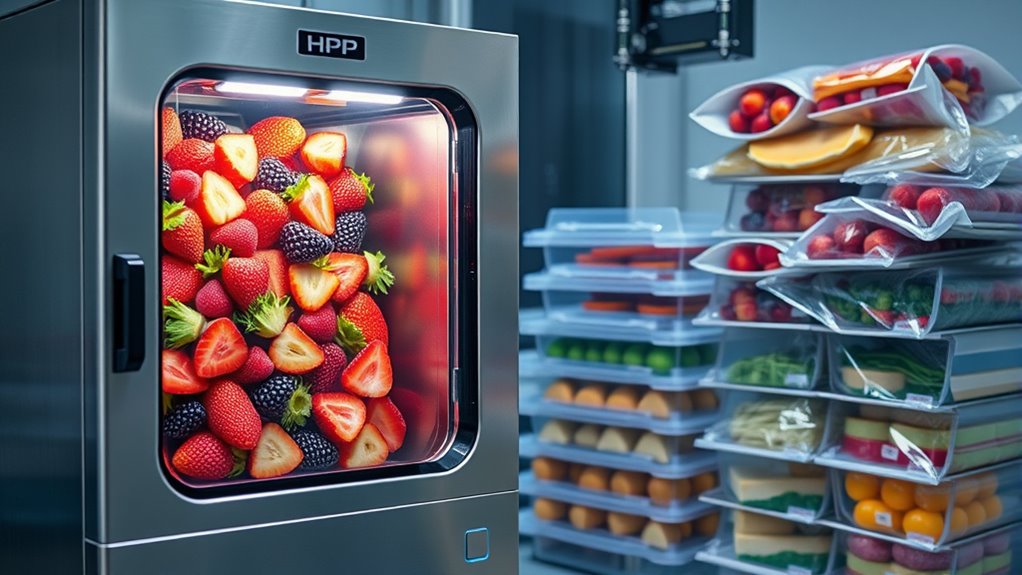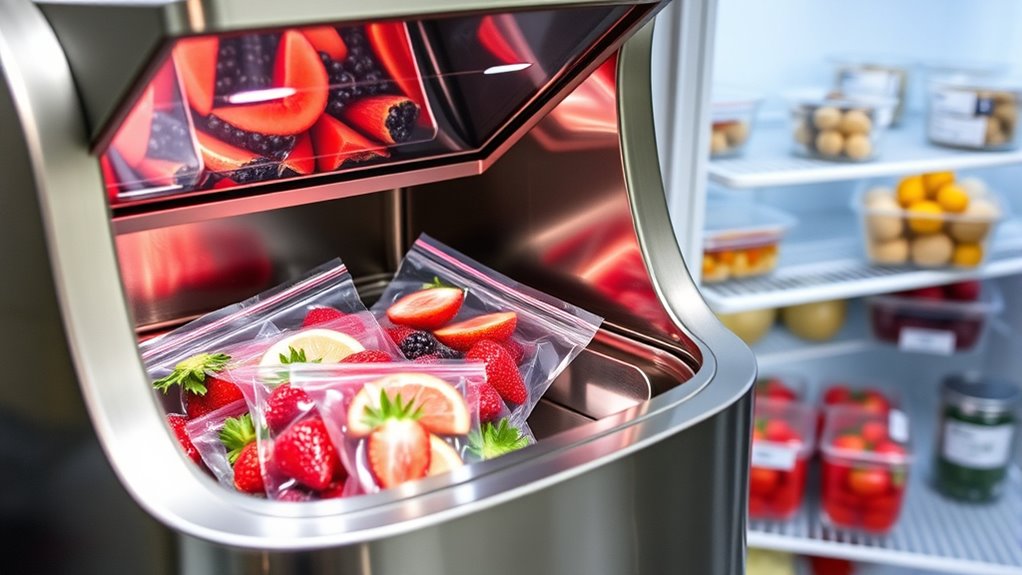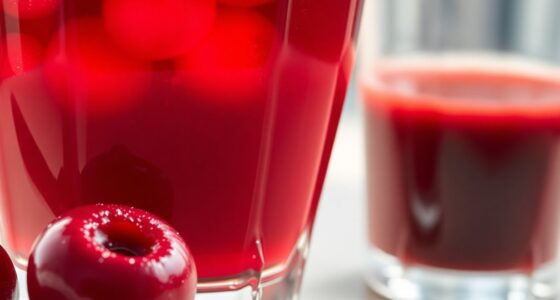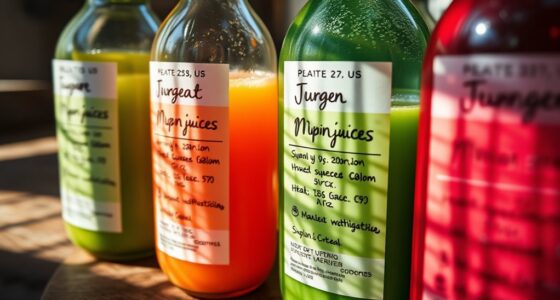To preserve foods processed with High-Pressure Processing (HPP), make sure to vacuum seal them to prevent oxidation and spoilage. Keep your packages at consistent refrigeration or freezing temperatures, as this slows bacteria and enzyme activity. Handle everything gently to avoid punctures and always label packages with dates. Monitoring temperature and storage conditions helps maintain freshness and nutritional value. Continue exploring these tips to guarantee your food stays safe, flavorful, and nutrient-rich longer.
Key Takeaways
- Combine HPP with vacuum sealing to prevent oxidation and bacterial growth, extending food freshness.
- Store HPP-treated foods at consistent refrigeration or freezing temperatures to inhibit microbial activity.
- Label packages with processing or storage dates to monitor freshness and ensure proper rotation.
- Handle vacuum-sealed packages gently to avoid punctures that compromise the seal and quality.
- Maintain proper storage environment with good ventilation and avoid temperature fluctuations for optimal preservation.

High-pressure processing (HPP) is an innovative method that uses intense pressure to preserve foods while maintaining their freshness and nutrients. This technique has gained popularity because it extends shelf life without relying on heat or chemical preservatives, making it ideal for fresh produce, juices, and ready-to-eat meals. When you combine HPP with proper storage methods, you’ll guarantee your food stays safe, flavorful, and nutrient-rich longer. One key aspect of effective storage is vacuum sealing. By removing air from packaging, you prevent oxidation and inhibit bacterial growth, which can cause spoilage. After HPP treatment, vacuum sealing is especially beneficial because it creates a tight barrier around the product, reducing exposure to moisture and contaminants. This process also helps maintain the food’s texture and flavor, assuring it tastes just as fresh as when it was processed.
Temperature control is equally essential in preserving the quality of HPP-treated foods. Once sealed, you should store your items at the appropriate temperature, typically in the refrigerator or freezer, depending on the product. Refrigeration slows down microbial activity and enzyme action, both of which can deteriorate food over time. Freezing, on the other hand, halts microbial growth altogether, making it the best option for long-term storage. It’s vital to keep the storage environment consistent; fluctuations in temperature can compromise the integrity of vacuum-sealed packages and allow bacteria to develop. Always check the recommended storage temperatures for specific foods, and invest in a reliable thermometer to monitor conditions regularly. Proper ventilation in your storage area can also help prevent moisture buildup and spoilage.
Another tip is to label your vacuum-sealed packages with the date of processing or storage. This helps you keep track of freshness and assures you consume the oldest items first, reducing waste. When you combine vacuum sealing and proper temperature control, you substantially extend the lifespan of your HPP-processed foods, preserving their nutritional value and flavor. Remember to handle packages gently to prevent punctures or tears, which could compromise the vacuum seal. When you’re ready to use the food, thaw it safely in the refrigerator or use other recommended methods, avoiding temperature shocks that could affect quality.
Frequently Asked Questions
Does HPP Affect the Nutritional Content of Foods?
Yes, HPP helps preserve the nutritional content of foods. It maintains food quality by reducing bacteria and pathogens without using heat, which can degrade nutrients. You’ll notice that processed foods retain more vitamins, minerals, and natural flavors compared to traditional methods. This means you get healthier, fresher-tasting options with better nutritional preservation, ensuring you enjoy high-quality foods that support your overall wellness.
Can HPP Extend the Shelf Life of All Food Types?
HPP can extend the shelf life of many food types, but it doesn’t work equally for all. You might notice changes in food texture, especially with delicate items, and cost considerations could influence your decision to use HPP. While it effectively preserves freshness and safety, some foods may not benefit as much, so consider the specific product and your storage needs before choosing HPP.
Are There Any Safety Concerns With Hpp-Treated Foods?
Did you know that HPP can inactivate up to 99.999% of harmful microbes? No, there are generally few safety concerns with HPP-treated foods, as the process enhances food safety by microbial inactivation without using heat or chemicals. However, some may worry about the potential for post-process contamination or altered texture. Overall, HPP is a safe method to reduce pathogens and extend shelf life, making your food safer to enjoy.
How Does HPP Compare to Traditional Preservation Methods?
You’ll find that HPP offers better pressure effectiveness than traditional methods, effectively inactivating pathogens without heat, preserving food’s freshness. Unlike canning or freezing, it retains more natural flavor and texture, making your meals taste better. Plus, HPP doesn’t rely on chemicals or additives, so it’s a safer, more natural preservation option. Overall, it’s a modern approach that keeps your food safe, fresh, and flavorful longer.
Is HPP Suitable for Home Use or Only Commercial Applications?
You might think HPP is out of reach for home use, but it’s really a case of “don’t throw the baby out with the bathwater.” While professional equipment is costly and bulky, smaller, more affordable home units are emerging. However, consider the cost considerations and space needed before jumping in. For now, it’s mainly suited for commercial applications, but the future may hold more accessible options for home enthusiasts.
Conclusion
By choosing high-pressure processing, storing your foods properly, and following these tips, you protect your health, preserve your flavors, and extend your food’s freshness. Embrace safe practices, enjoy nutritious meals, and enjoy peace of mind with each bite. With awareness and care, you guarantee quality, safety, and longevity in every step, transforming simple storage into a conscious act. Make smart choices, stay informed, and savor the benefits of well-preserved, high-pressure processed foods.
Cindy thoroughly researches juicing trends, techniques, and recipes to provide readers with practical advice and inspiration. Her writing style is accessible, engaging, and designed to make complex concepts easy to understand. Cindy’s dedication to promoting the advantages of juicing shines through her work, empowering readers to make positive changes in their lives through the simple act of juicing.











